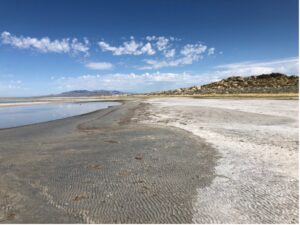Meet Emily Gaines Crockett, who joined the Environmental Dispute Resolution (EDR) program team at the University of Utah’s Wallace Stegner Center in December 2021. Emily manages EDR program administration and communication efforts.
 Tell us a little bit about yourself and what attracted you to join the EDR team as the program manager?
Tell us a little bit about yourself and what attracted you to join the EDR team as the program manager?
I initially kicked off my career traipsing through New England salt marshes with a research group from Woods Hole, Massachusetts. I loved everything about those marshes—the birds, the mud, even the humming insects—and because I wanted others to love them, too, I was drawn to the environmental education field. When I relocated to Utah to pursue a master’s in environmental science, the very first landmark I visited was Antelope Island in the Great Salt Lake. Its unusual ecosystem and striking beauty immediately drew me in. For several years I served as the Education & Outreach Director for a non-profit organization focused on protecting and preserving the Great Salt Lake Ecosystem. From there, I went on to manage a suite of science and environmental outreach programs at the University of Utah. As I have interacted with a variety of natural resource professionals throughout my career, I have seen how important it is for groups to work collaboratively through conflict, and how often attempts at collaboration fall apart. When the opportunity came available to join the Wallace Stegner Center Environmental Dispute Resolution (EDR) program team in 2021, I jumped at the chance to begin working more directly in this space.
What do you enjoy most about working on environmental and natural resource issues?
Environmental and natural resource issues are everywhere, and they affect everyone, even if we don’t realize it. In northern Utah, we are all breathing in air pollution, grappling with drought and wildfires, and worrying about what the future may bring. I have found work in environmental and natural resource issues to be especially meaningful because these issues carry so much significance in our daily lives, and in the lives of future generations.
Get notified when new articles are posted to the EDR blog. Sign up for our email list »
What do you most enjoy about working with the EDR program?
I’ve been with the EDR program for just a few short months, and I’ve already been blown away by the environmental, natural resource, and public policy professionals who engage with us. I am grateful to have the opportunity to support EDR program activities, such as the Collaboration Certificate course and the Collaborative Leadership Network, which help professionals develop their skill sets for collaborative problem solving. I am excited to continue supporting the important work of the EDR program, and I look forward to learning from the EDR program leaders, Danya Rumore and Nedra Chandler, as well as from our remarkable program participants.
What lessons have you learned about dispute resolution, collaboration, and/or dialogue?
Conflict is natural and normal, and when viewed through a positive lens, it can be an opportunity to collaborate and co-create lasting solutions. As I learn more about dispute resolution and collaborative problem solving, I continue to be struck by how these skills apply as much to our personal lives as they do to our professional ones.
I recently heard a story about two young children who were fighting over a toy. When the father intervened and asked if they knew what a compromise was, the oldest child said, “It’s when one of us cries.” As a parent, this anecdote resonated with me on so many levels. Whether we’re dealing with young children or seasoned professionals, there is a tendency to approach conflict as a situation where everyone loses a little, or someone loses a lot. The EDR program helps people see that conflict, if approached with the right skills and awareness, is an opportunity to find a collaborative solution that will yield positive results rather than upset.
From your perspective, what should people know about the EDR program?
While the EDR program is based at the University of Utah with a focus on the Intermountain West, it has a national reach. There are many facets to the EDR program and many ways to get involved, including:
- Teaching and trainings: The EDR program is a national leader in providing professional training on topics related to collaboration, conflict resolution, negotiation, facilitation, and leadership. We are currently accepting applications for our flagship Collaboration Certificate course, designed for mid- and upper-level professionals working on environmental, natural resource, and public policy issues.
- Coaching: EDR provides professional coaching primarily to leaders and teams who work in public roles—especially those who guide complex co-learning and public decisions on environment and natural resource issues. We also coach other coaches and third-party facilitators.
- Collaboration assistance: In limited, high-impact situations, the EDR program may be able to provide collaboration assistance and advising.
- Resources: Free tools and resources for collaboration are available on the EDR website.
- Connecting with our work: The EDR program is always seeking contributors for the EDR blog (contact edrprogram@law.utah.edu for more information). Folks may also wish to subscribe to our emails or make a donation.
What outdoor activities do you enjoy the most? Is there a particular place you enjoy visiting and why?
I enjoy walks and hikes with family and friends, and I particularly enjoy spending time at the Great Salt Lake. One of my favorite places to visit is the Great Salt Lake Nature Preserve, with its boardwalks meandering through the wetlands.
 Emily Gaines Crockett is the program manager for the Environmental Dispute Resolution (EDR) program at the Wallace Stegner Center, S.J. Quinney College of Law, University of Utah.
Emily Gaines Crockett is the program manager for the Environmental Dispute Resolution (EDR) program at the Wallace Stegner Center, S.J. Quinney College of Law, University of Utah.
